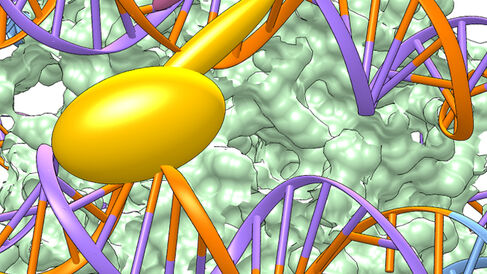
The Taipale Group and their collaborators have published a paper in Nature that identifies five mechanisms by which proteins can read genetic information from the tightly packaged form of DNA found inside human cells.
Every human cell contains around two meters of DNA. In order for this to fit inside the microscopic space of a cell nucleus it has to be packaged very tightly. Protein 'reels', called histones, enable DNA to be condensed into a much smaller volume through the formation of structures called nucleosomes. In each nucleosome, DNA is wrapped neatly around the histones almost twice, in a manner similar to a garden hose being wound up around a reel. Although this process allows DNA to be packaged into the nucleus, it causes the DNA within nucleosomes to be inaccessible, which was previously thought to prevent instructions within DNA from being 'read' by other molecules without unwinding the DNA first.
Scientists in the Taipale Group have now discovered how messages that describe when and where genes are active can be read by the cell, even when the DNA that contains such messages is wound into nucleosomes.
In their new study, the authors wrapped random DNA sequences onto nucleosomes and then allowed 223 proteins called transcription factors (which bind DNA to control gene activity) to interact with the nucleosomal DNA. They found that the nucleosome changes the mechanism by which transcription factors interact with DNA in five alternative ways:
- In the first case, transcription factor proteins bound to two different DNA strands, aided by the fact that the strands were close to each other on the nucleosome reel.
- In the second mechanism, proteins bound to DNA such that the nucleosome was more commonly located to one side of them.
- In the third case, many transcription factors bound to segments of DNA that were close to the end of a nucleosome.
- The fourth type of binding occurred on the side of DNA that does not contact the nucleosome reel.
- Finally, some transcription factors could bind to the position in the middle of the nucleosome reel where only one DNA strand was wound.
Most transcription factors studied could bind to nucleosomal DNA by at least one of these mechanisms, whilst many could use multiple different methods to contact their target sequences.
The authors found also that binding of some transcription factors made the nucleosome more stable. Most binding events, however, help to unwrap DNA from the histone reel. Removal of the histones is necessary for activation of gene expression, so these findings partly explain why transcription factors can either activate or repress gene expression.
The packaging of DNA on nucleosomes makes it more difficult for transcription factors to access DNA. This new study shows that these proteins have evolved several different mechanisms to get around the problem, allowing them to read the important messages in our genome that tell cells how to construct and maintain our tissues and organs.
The reported findings uncover a rich, interactive landscape between transcription factors and the nucleosome, thus paving a way to a thorough understanding of the complicated DNA decoding mechanisms in higher organisms. The findings also provide a basis for future studies aimed at understanding transcriptional regulation based on biochemical principles. As aberrant transcription factor activity is linked to many human diseases, including cancer, the findings are also relevant to understanding mechanisms of human disease.
